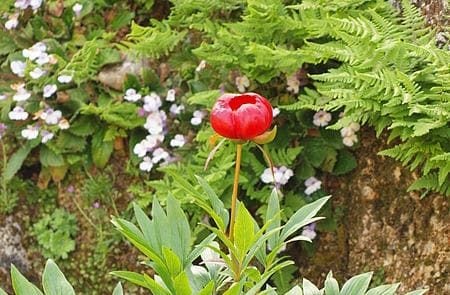
A list of the ten most iconic flowers of Greece is not difficult to create since Greece is home to some of the most spectacular flowers in the world. One of the most striking things one notices on leaving the airport and getting into the countryside is that the even highways are lined with overflowing borders of pink and white oleander.
One would think that any country that has such luxuriant flowers lining the most out-of-the-way roads must be full of a wealth of flora. And you would be right.
From the saffron crocuses that Minoan women were pictured gathering in frescoes in Minoan times, to the blood-red peonies of Mt. Parnassus, to the golden blossoms of Sideritis clandestina—with which Greek Mountain Tea is made—Greece has an endless bounty of blossoms. Below are ten of the most iconic of these flowers.
The flower of the Acropolis, Micromeria acropolitana
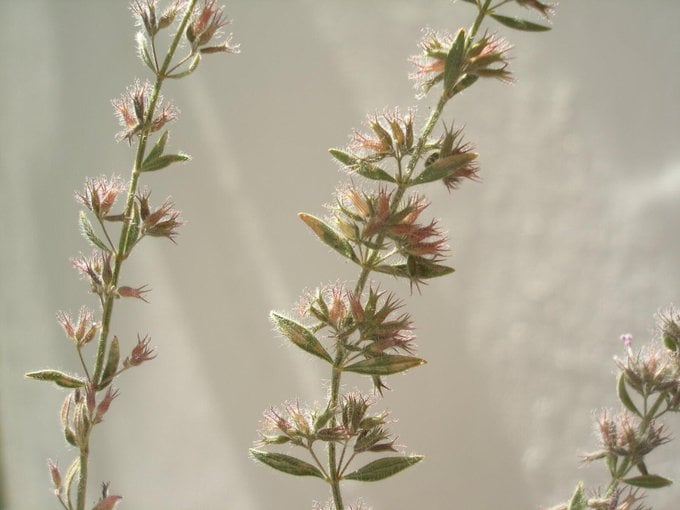
Found interspersed among the rocky terrain of the Acropolis of Athens is a small plant that features the most delicate of little pink flowers, called the Micromeria acropolitana.
Measuring just five to thirty cm (up to twelve inches) in height, it is easy to walk past this plant without even noticing it. Yet this modest flower, which is beloved by Greeks and botanists alike, has an interesting history in itself.
This unassuming but lovely plant is completely unique, as it only grows on the Acropolis, the ancient hill of Athens, home to the Parthenon, the most iconic structure in the history of Western civilization, ensuring it is at the top of the list of the most emblematic flowers of Greece.
The Micromeria acropolitana blooms every year from May until June when its beautiful flowers emerge and dot the rocks of the Acropolis with notes of pink.
The plant was discovered in the summer of 1906 by two French botanists, Rene C.J.E. Maire and Marcel G.C. Petitmengin, and was included in their work “In Acropoli Athenarum.”
Oddly, the plant appeared to go extinct soon after it was discovered, but it reemerged on the Acropolis in 2006 a hundred years after it was first found. It had been included in the Greek state’s official catalogue of protected plants by order of a Presidential Decree in 1981 during the period that it was thought to have been extinct.
The Greek biologist, Grigoris Tsounis, was the first to rediscover the supposedly extinct plant in 2006 with his son Lambros. The pair stumbled across a secluded area of the Acropolis where over two hundred of the plants were thriving.
Greek peony, Paeonia parnassica
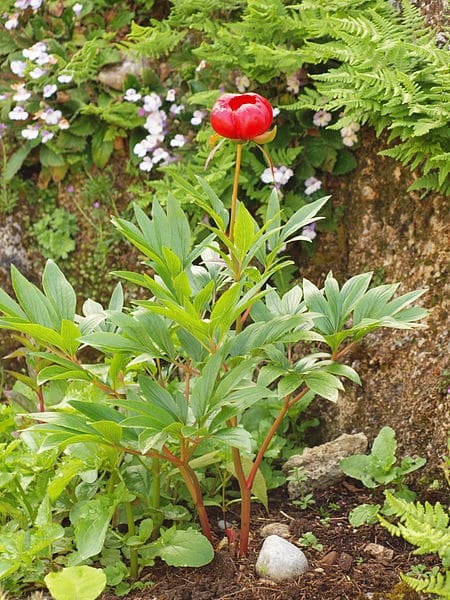
Native to towering Mount Parnassus, which looms over the ancient site of Delphi, this blood-red gem must freeze during the winters, making them endemic to high places that experience cold winters. The reward for all those who experience these cold seasons is to have peonies, which are not only spectacular to look at but fragrant as well, with a scent like roses.
Thriving at up to an incredible 1,500 meters, (4,921 feet), the Greek peony is sadly considered to be a vulnerable plant, since many people have taken them from the wild, despite the fact that the European Union has regulations regarding its protection.
The entire genus of Paeonia, which now is seen all over the world, is named after Paean, a healer from Greek mythology who legends say first discovered the many medicinal powers of these plants, which ancient physicians such as Galen believed cured nightmares and warded off the spasms of epilepsy.
Laconian Thyme, Croceae laconiae
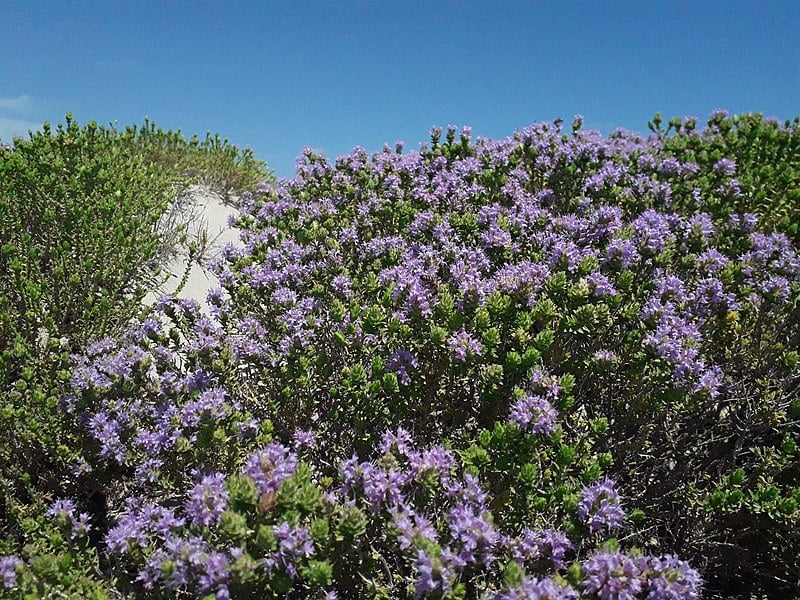
As fragrant as you would imagine, this herb is also as rugged as the Greek landscape, found growing not only amongst the rocks of the southeastern part of the Peloponnese at Cape Maleas but also far up into the mountains of Laconia up to 900 meters (2,952 feet) in altitude.
Laconian thyme, which has orchid-colored blossoms, enjoys brisk mountain and sea breezes, and it tolerates drought well. It is, all in all, a flower that is perfectly adapted to the Greek landscape, surely making it onto any list of the most iconic flowers of Greece.
Rugged and brushy in form, it has many branches coming off a hard, woody stem. Its scent is intoxicating to bees, which pollinate its delicate blooms in early summer. Laconian thyme, like so much of Greece’s natural bounty, can be used in a wide range of savory meat dishes as well as soups and even breads.
Crocus cartwrightianus, the autumn-blooming saffron crocus
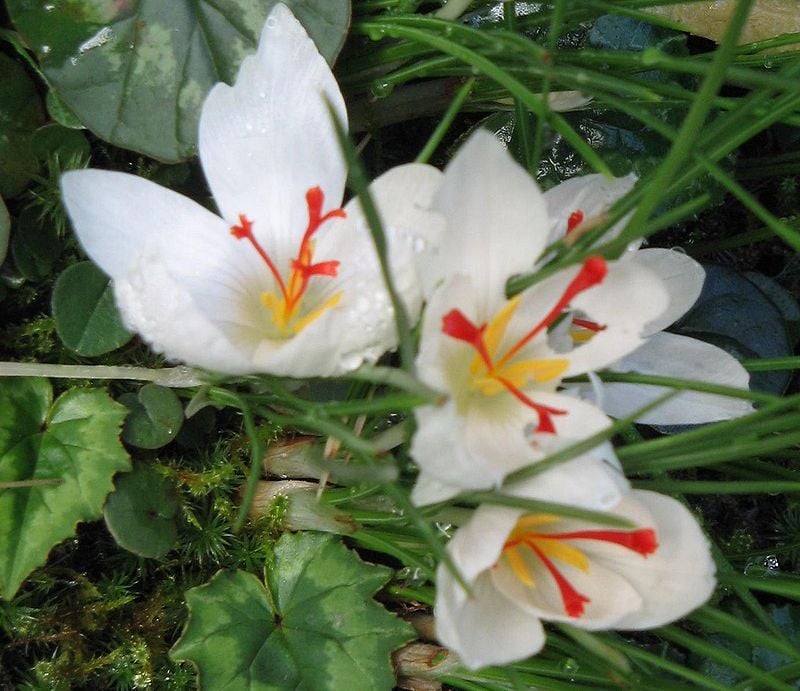
Another of the most iconic flowers of Greece, Crocus cartwrightianus, named in the 1800s for John Cartwright, the British consul to Constantinople, belongs to the family Iridaceae. Native to mainland Greece and Crete, it was likely cultivated in ancient Crete at least as early as the Middle Minoan Period, as seen in the spectacularly beautiful fresco called The Saffron Gatherer, depicting a Minoan woman gathering crocuses in a field.
Used for the saffron that is part of their stigmas, C. cartwrightianus is presumed to be the wild progenitor of the domesticated Crocus sativus, which is now cultivated around the world.
A cormous perennial, commonly found growing in limestone soils in Attica and other sites in mainland Greece, has flowers in shades of lilac or white, with purple veins and prominent red stigmas. This variety of crocus, unlike those which have naturalized in other Northern areas, blooms in the autumn and winter.
Crocus cartwrightianus has served humanity in so many ways, including the use of its saffron as a fabric dye and as a spice, that it earned the Royal Horticultural Society’s “Award of Garden Merit.”
Greek Mountain Tea—Sideritis clandestina, taygeta,and athoa
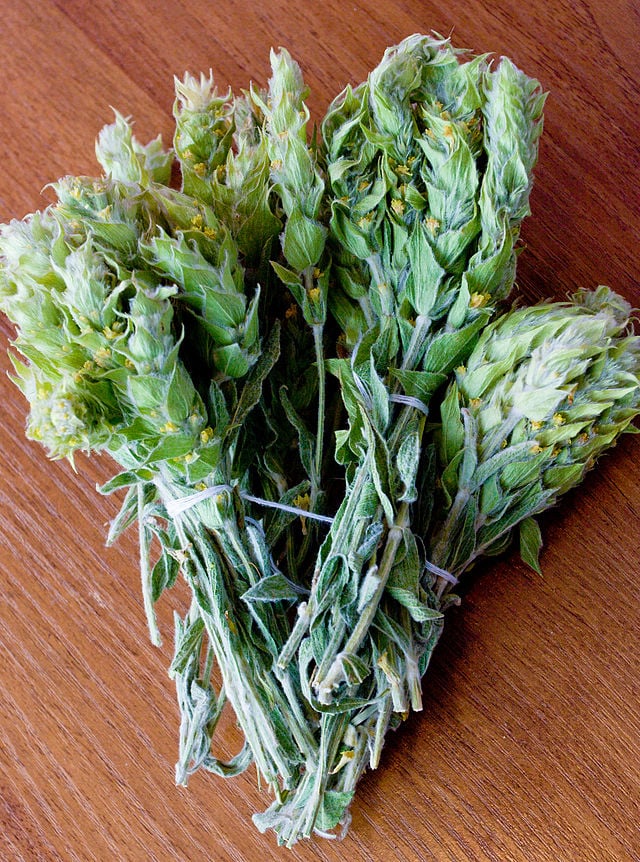
Also known as ironwort, Greek and Cretan mountain tea, and Shepherd’s tea, the Sideritis flower belongs to a genus of flowering plants known for their traditional use as an aromatic—and medicinal—herbal tea. Sideritis is abundant throughout the Mediterranean regions.
This hardy perennial grows to 15 to 40 cm tall. So far, studies have shown that it contains Terpenes, flavonoids, essential oils, iridoids, coumarins, lignans, and sterols.
Although its healing properties have been highly valued by Greek yiayias throughout the millennia, and it has been studied by the European Medicines Agency, as of now the jury is out regarding exactly how the concoctions made from its leaves work to make you feel better.
Sideritis is found growing on rocky slopes at elevations over 1000 meters (3,280 feet); a hardy flowering staple of the Greek mountains, it is now cultivated for its use in an array of teas.
There are seventeen different species indigenous to Greece alone, including Sideritis athoa, which grows on Mount Athos; Sideritis clandestina, which grows on Mount Helmos and Taygetos; Sideritis scardica of Mount Olympus; Sideritis raeseri of Mount Parnassus; Sideritis syriaca from the mountains of Crete, known as malotira; and Siderities euboea, which is native to the mountains of the island of Evia.
This perennial herb has pride of place on any list of the most iconic flowers of Greece. With a strong, woody stem, Sideritis is used in what those in the local area call Tea of Olympos. The variety of Sideritis found in rocky areas in Northern Greece is made into Velouchi tea and Parnassos Tea.
Sideritis syrίαcα, which grows wild but is also now cultivated on the island of Crete, is also known as malotira male (illness) and tirare (pull), perhaps because it is supposed to “pull” the illness out of you. Widespread in the rugged, rocky mountainsides of Greece, it occupies a special place in the history of Greece, which has a long history of employing natural remedies for a host of ailments.
“Apple-bearing” sage, Salvia pomifera
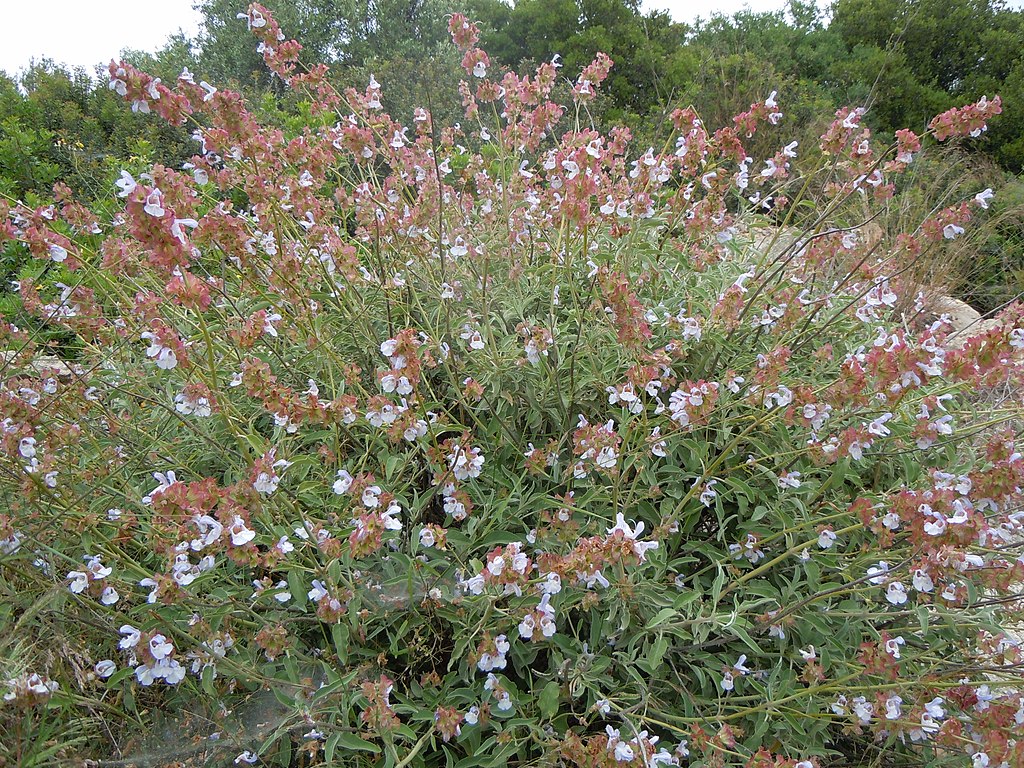
Salvia pomifera, or “apple-bearing sage” grows as an evergreen shrub up to one meter (3 feet 3 inches)high by one meter wide.
Although not hardy in colder climes, in Greece it survives all year round and is in flower from May to July. The leaves, like all others in the sage family, have a strong odor and flavor, resembling lavender and common sage. When dried, they have a host of culinary uses, including in flavoring meats and other savory dishes.
Salvia pomifera is used as an adulterant of sage as a commercial food flavoring; of course, this being Greece, an infusion of the herb is also used to make a tea. Very fragrant, it is just another of the almost endless array of teas that are used in Greece for medicinal purposes.
Semi-transparent galls are formed on the plant as a result of gall wasps colonizing its branches when young; like so many other things belonging to nature’s bounty in Greece, they have been made into a kind of conserve or jelly by crystallizing them in sugar; this is regarded as a great delicacy by some Greeks who are fortunate enough to taste it.
Olympus Yarrow, Achillea ambrosiaca
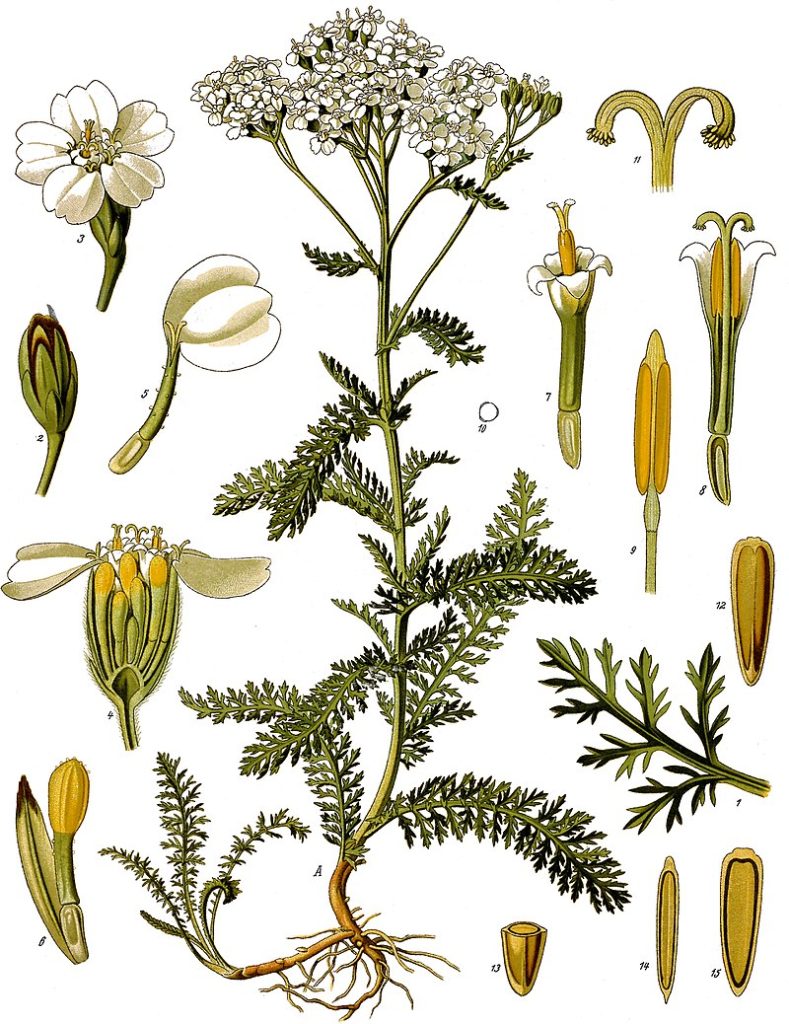
Although it belongs to the enormous genus of yarrows, which grow all over the world, this small, delicate flower grows only on what was the holiest mountain in Greek mythology, Mount Olympus. Thriving at an altitude of 2,900 meters, along not only its rocky slopes, but in its alpine meadows as well, it is only rarely seen at altitudes below 2,000 meters, according to biologist Orestes Davias, a biologist writing for the website “Greece-is.”
As an endangered flower that is certainly among the most iconic of the flowers of Greece, and collecting its leaves and white flower clusters is strictly forbidden. However, in the past, it was used for its unusual fragrance and its supposed anti-aging effects on skin, becoming known as ambrosia, since that was the food of the immortal gods. If it is grown at lower altitudes, Davias notes, the flower is unfortunately vulnerable to diseases.
Flowers of Greece: Mt. Athos Immortelle, Helichrysum sibthorpii
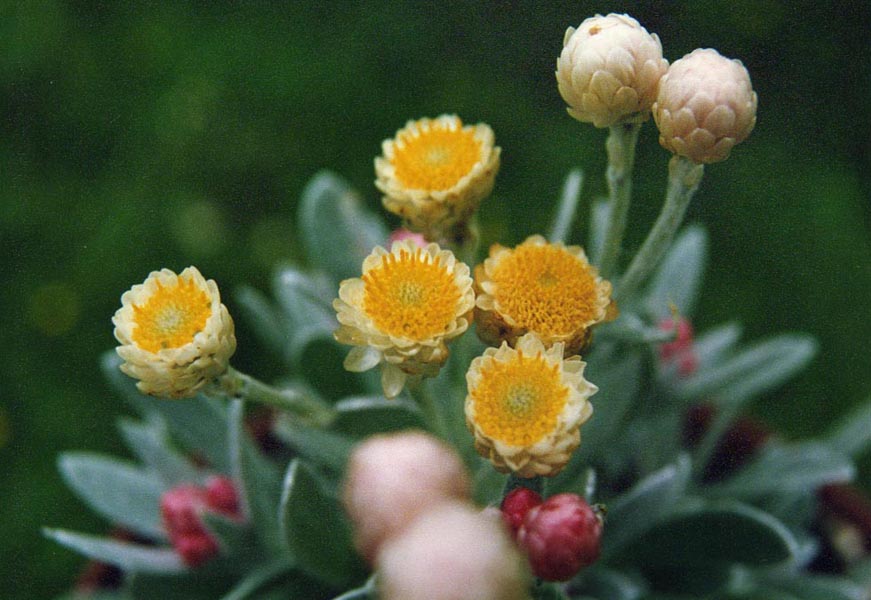
Helichrysum sibthorpii, although assuredly seen by many Greeks since time immemorial, was first entered in the written records of taxonomists after climbing enthusiasts Sibthorp and Bauer came upon specimens of the flower on their ascent of Mt. Athos on August 11, 1787.
In accordance with the religious nature of the Athos peninsula, which comprises a complex of twenty different monasteries, it was subsequently described as Gnaphalium virgineum, after the Holy Virgin, who is considered to be the only woman allowed on Athos.
When the tiny flower, which resembles a small daisy when fully open, was later transferred to the genus Helichrysum, it had to change its name for nomenclatural reasons. It is now named after its formal discoverer. It is a rare and endangered flower, which lives in the crevices of limestone cliffs in only the uppermost one hundred meters (328 feet) of the 6,670-foot Holy Mountain.
Cretan Dittany, Origanum dictamnus

Figuring prominently in Greek mythology and folklore, Cretan dittany, also known as Eronda, Diktamo, hop marjoram, wintersweet, and wild marjoram is an herbaceous perennial that grows as a native on the rocky outcrops of Crete, Greece’s largest island.
Growing 6 to 12 inches (15-30 cm) high, this herb with its sweet, round, fuzzy greyish leaves also has pale, orchid-colored flower stalks, which bloom during the summer.
Cretan dittany not only featured in Greek mythology, but was also “used as a medicinal herb through medieval times, and as a perfume and flavoring for drinks such as vermouth, absinthe and Benedictine liqueur,” according to the authors of gardeningknowhow.com. The website also has tips on how to best cultivate this useful herb found here.
Its flowers are brewed into an herbal tea that Greek yiayias again maintain can cure all types of ailments. But it can also be used as an herb to flavor a host of dishes, and can be combined well with parsley, thyme, and garlic.
It is still cultivated in Embaros and other areas near Heraklion, Crete. Used since Minoan times, Cretan dittany was employed in everything from cosmetic preparations to a medicinal salve and a tea used for digestive problems, wound healing, easing the pains of childbirth, and rheumatism.
Incredibly, the Cretan herb was listed by Charlemagne in his medieval-era itemization of useful herbs; the Ancient Greek physician Hippocrates believed it cured a host of human ailments.
Figuring heavily in Greek mythology, Cretan dittany symbolized love. Also said to be an aphrodisiac, it was given by young men to their lovers. One of its many familiar names is Eronda, or “love.” The young lovers who look for the herb in order to give it to their beloved are called ‘Erondades,” or ‘love seekers.’
Mt. Juktas St. Johns Wort, Hypericum jovis
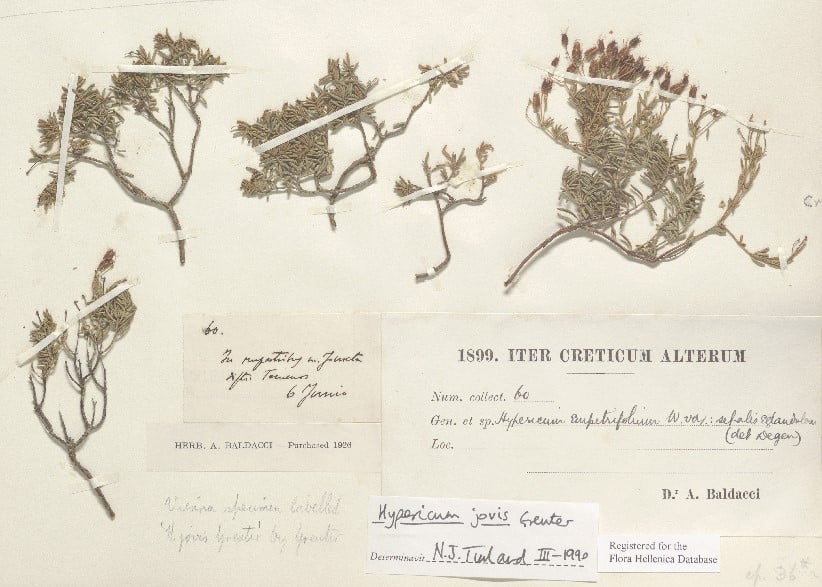
Living only on the craggy mountains of Central Crete, this plant grows at altitudes approaching 1,500 meters (4,921 feet), and as you would imagine, it thrives in only the type of rocky, limestone soils that are found there.
Thought to be vulnerable but not yet endangered, the plant is related to Hypericum perforatum, the type of St. John’s wort that is used as an antidepressant and a healing agent. Of course, this Greek gem also has an ancient Greek name although it was recycled through the Romans.
Called Hypericum jovis after the Roman name Jove, for the king of all the gods on Mt. Olympus, it earned that moniker because it grows on a mountain, Juktas, which is said to be home to Zeus’ tomb.


